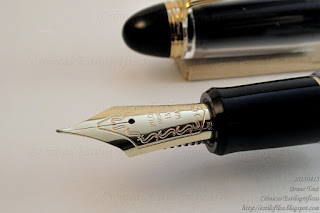And there are more variations beyond the unique –so to speak— coloring of the pen: the nib is not engraved with any sign save with the gold purity –18 K gold— and the nib point. 18 K is not the usual gold grade implemented by Sailor on its pens (save in the case of the ultra-thin Chalana), but we have already seen 18 K Sailor nibs on Davidoff’s pens.
A very interesting detail here is how keen Sailor is to make limited editions for whoever demanded it. It seems that the basic order is of just 10 pens. On this particular case, YY Pen Club ordered 30 units, not numbered. Its distribution is only done through that club of pen users. In that regard, this is not so much of a limited as it is a commemorative pen for a private organization.
My thanks to Mr. Sunami.
Sailor pocket pen, quasi inlaid nib – Montblanc Racing Green
Bruno Taut
Nakano, July 5th, 2015
etiquetas: Sailor, mercado
Bruno Taut
Nakano, July 5th, 2015
etiquetas: Sailor, mercado






























































